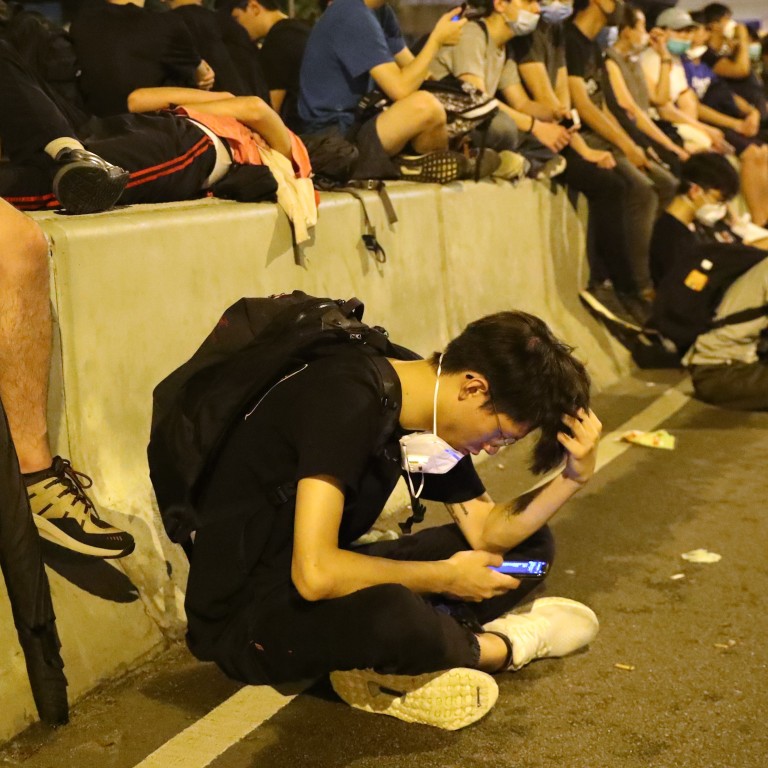
From Facebook and Twitter to Telegram, WhatsApp and Signal: how protest technology has evolved since Occupy Central
- Encrypted messenger apps used by protesters to organise themselves, share intelligence and avoid police detection
- But police arrest a Telegram group administrator on suspicion of conspiracy to commit public nuisance
As thousands of demonstrators occupied major routes in the heart of Hong Kong on Wednesday, messaging apps such as Telegram, WhatsApp and Signal emerged as the key tools for agitators to coordinate their operations.
Their role in the protests was highlighted when the administrator of a Telegram group was arrested for conspiracy to commit public nuisance, after police turned up at his home on Tuesday night.
The basis of the allegations against Ivan Ip, who is in his 20s and managed a conversation involving 30,000 members, is that he plotted with others to charge the Legislative Council Complex and block neighbouring roads.
Other young people, including high school students, used encrypted messages to exchange details on how and where to best target their anger.
Protesters circulated pleas on Telegram groups, requesting additional supplies such as riot gear and first aid kits. Some of these groups have tens of thousands of members.
This did not stop the mass of well-organised young people. They could always resort to the age-old method of communicating with a large crowd: shouting.
Technology is not just a tool for organising protests. It is also hoped that by using secure messaging platforms, demonstrators can avoid surveillance and persecution.

“People are smarter around technology now. They are using tech in a way that doesn’t give you away,” said Lokman Tsui, a professor at Chinese University researching media and technology.
One way to keep safe, he said, is to turn off Face ID and Touch ID on iPhones, features which enable users to log in using their fingerprint or by simply looking at their device.
Laws in Hong Kong ensure that people have a right not to incriminate themselves, which includes refusing to reveal the pin code to your phone.
However, authorities could force unwilling detainees to unlock their handsets using facial recognition or fingerprints, without their consent.
But he also said some apps, such as Telegram, are not as safe as protesters assume they are. Unlike WhatsApp and iMessage, messages over Telegram are not end-to-end encrypted by default.
“Most people don't know that they have to actually turn it on,” Tsui said.
Carrie Lam accuses anti-extradition bill protesters of ‘organising a riot’
The preference for secure encrypted messenger is different to the Occupy Central protests in 2014 when social media platforms such as Facebook and Twitter were widely used.
During the early days of Occupy Central, between September 26 and 30, 2014, more than 1.3 million messages about Hong Kong were posted on Twitter.
Although Facebook and Twitter are still being used to share news about the current protests against the extradition bill, much of the sensitive information sharing and coordination has moved onto Telegram and Signal.
“There seems to be more social or organisation groups and private groups on Telegram now,” said Harvey, a Hong Kong resident who has participated in both Occupy Central and the current protests.
He did not wish to be identified by his name.
Concerns about privacy spill into the offline world. One protester told us some of her friends stopped using Octopus, a contactless payment card, widely used for public transport in Hong Kong.
Each card has a unique serial number. Some are linked to data such as name, date of birth and identity card number, leading to fears they can expose vital clues about a user’s whereabouts.
Keyboard Frontline, an NGO advocating a free online environment, has published a booklet on how protesters can protect their identity.
It includes not using public Wi-fi, leaving phones at home – and even protecting ID cards, passports and bank cards by wrapping them in aluminium.
This is done to protect personal information against radio frequency identification (RFID) scanners, said Glacier Chung Ching Kwong, a core member of Keyboard Frontline.
“There is a lot of uncertainty on what can or cannot be traced that's why there is so many conspiracy theories coming up,” says Tsui.
Additional reporting by Danny Mok


